Bottom Line
- The Big Sky Soul 1P is a lightweight, double-wall, freestanding, 3-season solo tent available in both regular and bikepacking (short poles) versions.
- I’ve bikepacked, backpacked, and traveled extensively with this tent for years. I’ve tested it in nearly every condition imaginable and it’s always excelled.
- I love that it’s lightweight, completely freestanding (even the vestibule), super-fast to pitch, and very affordable. It’s one of my favorite pieces of gear.
My solo tent is my sanctuary. At the end of a long day, whether backpacking in the mountains of California or bicycling across the Sahara desert, I look forward to crawling into my tent as if I’m climbing into my cozy bed at home.
My favorite home away from home — after 16 countries, many thousands of miles, and countless nights — is still the Soul 1P Tent from Big Sky. I started using the original version back in 2018 while backpacking around Africa. When the bikepacking bug bit me hard the Soul became my primary bikepacking tent, just before bikepacking.com awarded it “Gear of the Year” in 2021. By 2023 the zipper on my well-loved original Soul was beginning to give out, so I upgraded to the new version (you’ll see pictures of both throughout this review).
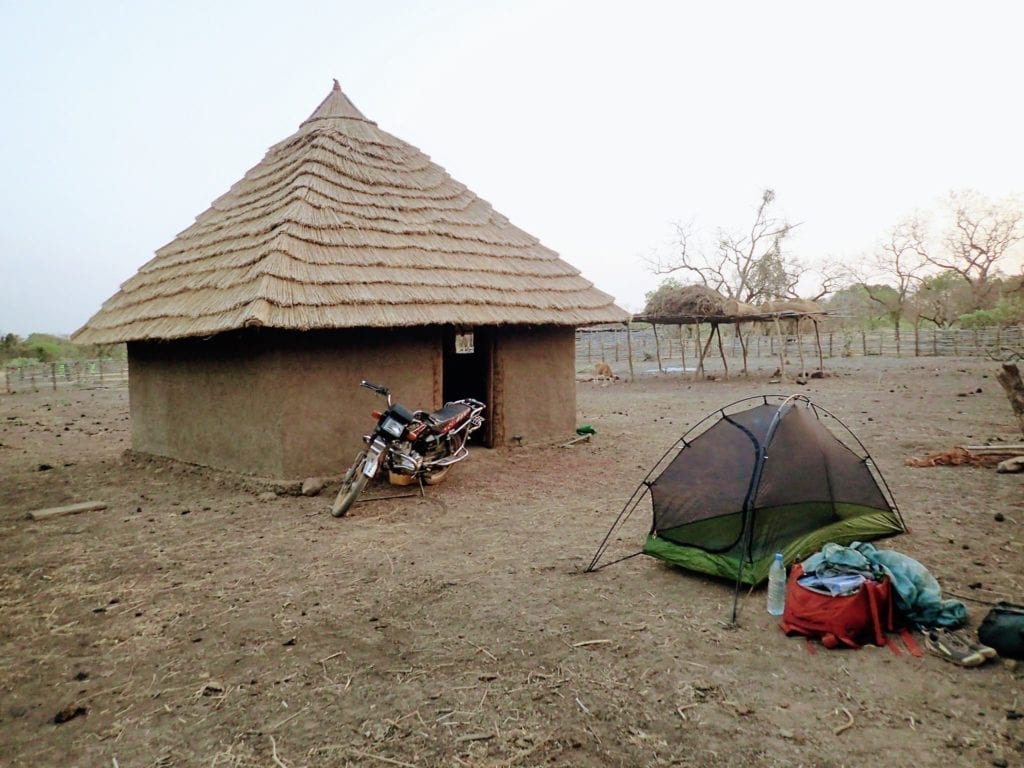
2018: Trekking in rural Guinea with my original Soul 1P tent (fly is off in this picture).
Though I’ve tested a number of other popular tents over the last few years, the Soul remains my go-to solo bikepacking tent. I’ve also used it for backpacking trips, though not as extensively (I’ve mostly transitioned to a tarp and bivvy setup when on foot). This review was originally published in 2019 and has been updated several times, most recently in spring 2024 after a windy trip in the Anza Borrego Desert.
Big Sky is a small Montana-based company that mostly flies under the radar, but their tents beat the big players in both price and weight. In this review I’ll explain what’s unique about the Soul’s design, how it’s held up for me during extensive use, and what stands out about it in a side-by-side comparison against the bigger players.
Related: Bikepacking Tents: How to Choose + Top Picks
Shop Bikepacking Resources
When you buy through affiliate links in this post, I may earn a small commission. Thanks for your support! I always offer unbiased opinions based on real experience from the road and trail. Learn more.
Big Sky Soul 1P Tent Overview
Price: $350 (bikepacking poles), $380 (regular poles)
Use discount code EXPLORINGWILD for 10% off at Big Sky International
Weight: 2 lbs 5.8 oz (bikepacking version), 2 lbs 3.7 oz (regular version)
Size: 1 person (2 person also available)
Style: double wall free-standing
Seasons: 3 (not a winter tent)
My rating: 4.8 stars out of 5
Buy it at: Big Sky International
Upgrades: Ultralight enthusiasts can get a version with lightweight fabric substitutions that weighs 1 lb 6.3 oz and costs $800. For most people the original version is a better value and plenty light enough.
The Verdict: The Big Sky Soul 1P tent offers an unmatched combination of light weight, affordability, and freestanding convenience. It’s super-quick to pitch, suits a wide range of climates, and feels surprisingly roomy inside thanks to the tapered floor. I’ve used mine for many thousands of miles of bikepacking and backpacking, and despite having tested other tents I still keep reaching for the Soul.
What I love about the Soul:
- Completely freestanding design can be pitched on any surface without stakes, even the vestibule
- Feels spacious inside thanks to dramatically tapered floor shape
- Double wall design with mesh inner suits variety of climates and conditions
- Quick and easy setup
- Available in bikepacking version with shorter 12″ poles
- Stealthy color blends into many landscapes
- Made by a small US company with excellent customer service
Potential drawbacks:
- Front entrance is unusual, some people don’t like it
- Vestibule is small
- Only one small inner pocket and no lofts, clotheslines or other features
- Some durability issues after lots of use
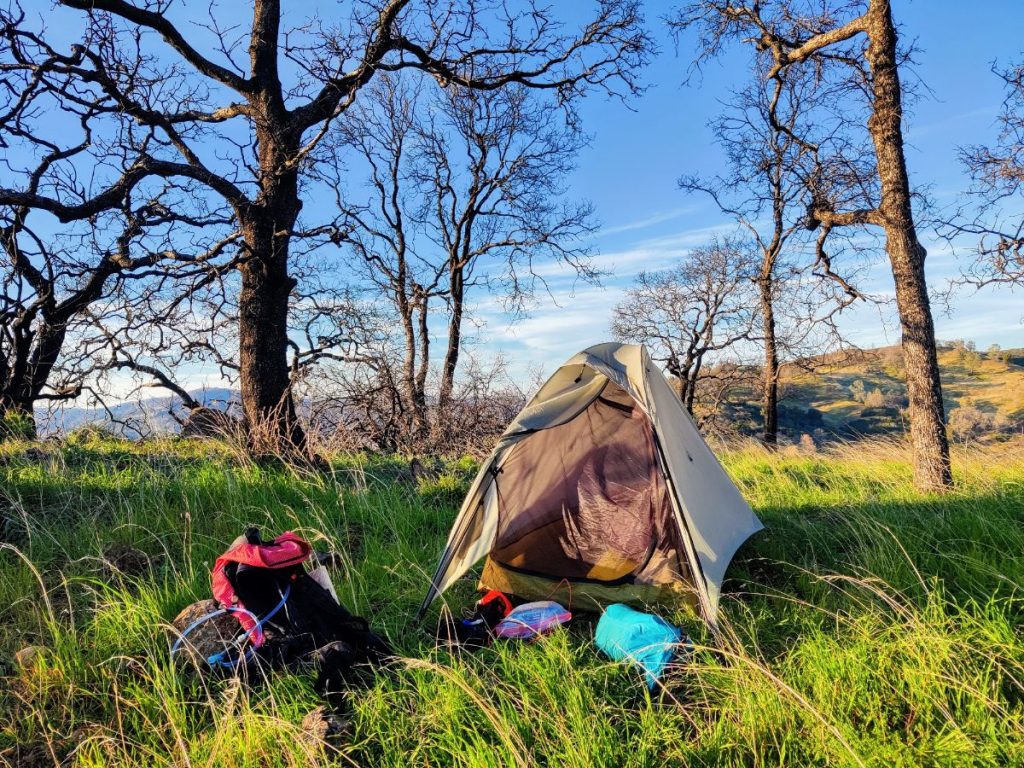
Backpacking with my Soul 1P tent in Henry Coe State Park.
Updated Soul 1P (Rev B)
After a rough year of manufacturing delays throughout the industry, Big Sky released a long-awaited update to the Soul 1P in 2023 (called Rev B on their website).
Improvements included increased weather protection (lower fly and more breathable fabric on the inner) improved durability (no more elastic webbing), and lighter weight (changes to how the fly attaches to the inner).
After using both, I can say the new version looks and feels like a slightly more polished and weather-resistant version of the original.
The only potential downside, which won’t apply to most users, is that the added fabric on the inner makes it slightly less breezy in hot climates. Back when I was using the original Soul in West Africa, where the climate is hot and I needed the mesh for mosquito protection, this would have been a drawback. For most users the added warmth and wind protection is a benefit.
This review has pictures of both the old and new version throughout. Here are some pictures specifically highlighting the new version:
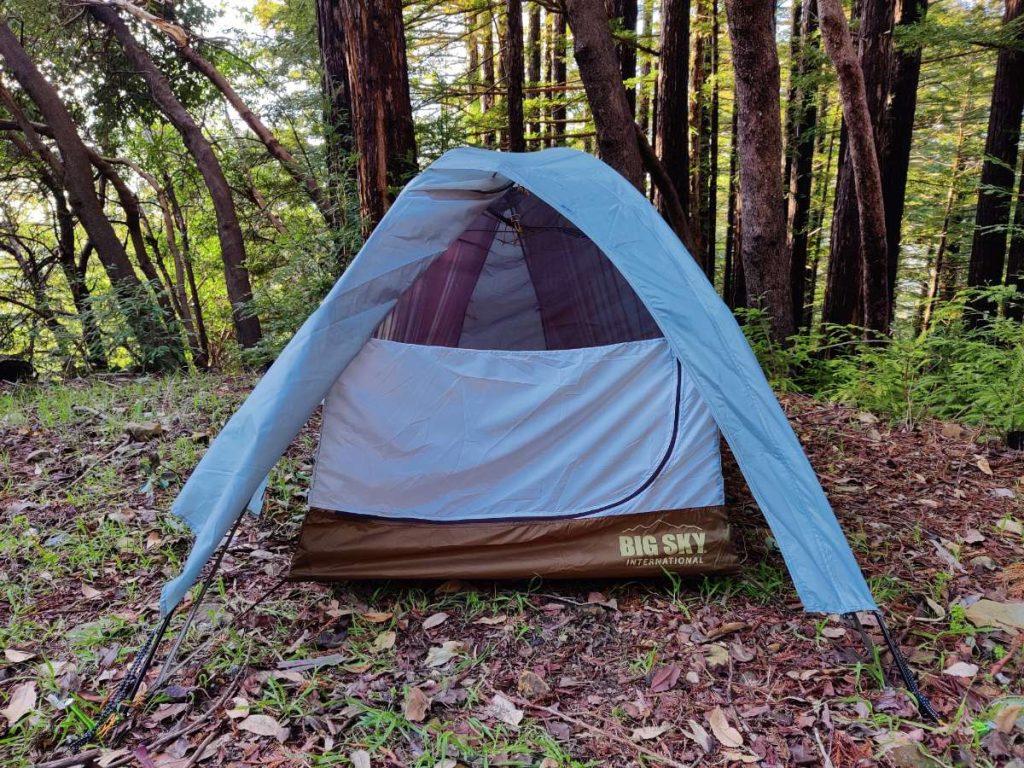
The updated Big Sky Soul is very similar but has a couple key improvements, like the fabric band shown here for better wind protection.
Fully Freestanding, Including Vestibule
The Soul’s most unique feature is its fully freestanding design. Most freestanding tents still require a stake or two for the vestibule, but the Soul’s unusual front entrance creates a small vestibule space between the poles and the inner door. This means you can pitch the entire structure without any stakes, keeping gear tucked away and dry even when stakes aren’t an option.
Why is freestanding so important? It’s a bikepacker thing. Though short trips in the backcountry usually offer ample dirt for tent stakes, long-distance bikepacking trips bring more varied circumstances. I’ve pitched my Soul in parking lots, on porches, and inside barns and abandoned buildings, always thankful for the freestanding no-stakes-needed design.
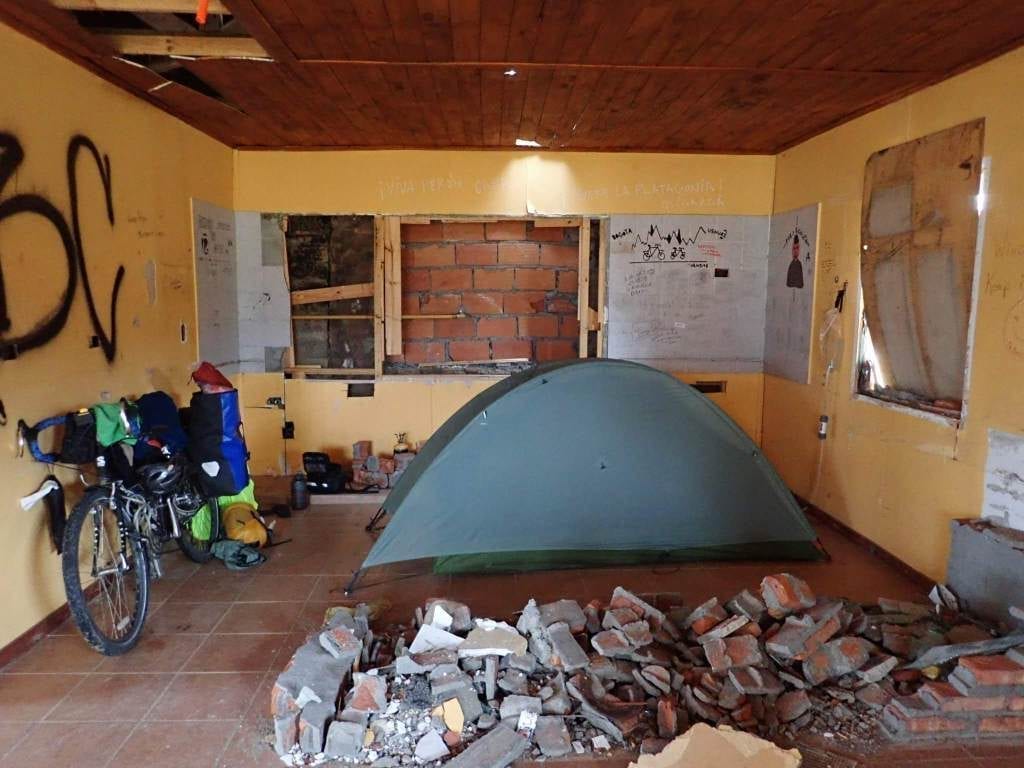
Sometimes staking your tent is not an option, as shown here in Argentina where the abandoned Pink House shelters bike travelers from howling winds.
Even if you don’t often pitch up on concrete, a freestanding tent is a convenience. On especially soft or hard ground or on very windy nights, the fewer mandatory stakes, the better. If nothing else it’s a convenience that makes setup faster and easier, a benefit we can all appreciate after a few nights on the trail.
How Helpful is the Front Vestibule?
The Soul’s freestanding front vestibule is a unique nice-to-have, but in my experience it’s rarely essential. Bikepackers can guy out a side vestibule to their bike for a stake-free solution on hard ground.
The front vestibule also comes with usability tradeoffs. It’s smaller than most side vestibules, so it holds less gear. It’s also not ideal for cooking in, something that should always be done with great caution (the Soul’s fabric, like that of many tents, is flammable). I will say that it’s doable, at least with my minimalist little cook setup, but not recommended.
Therefore, if you’re leaning toward the Evolution over the Soul, I wouldn’t let the Evolution’s non-freestanding side vestibule discourage you.
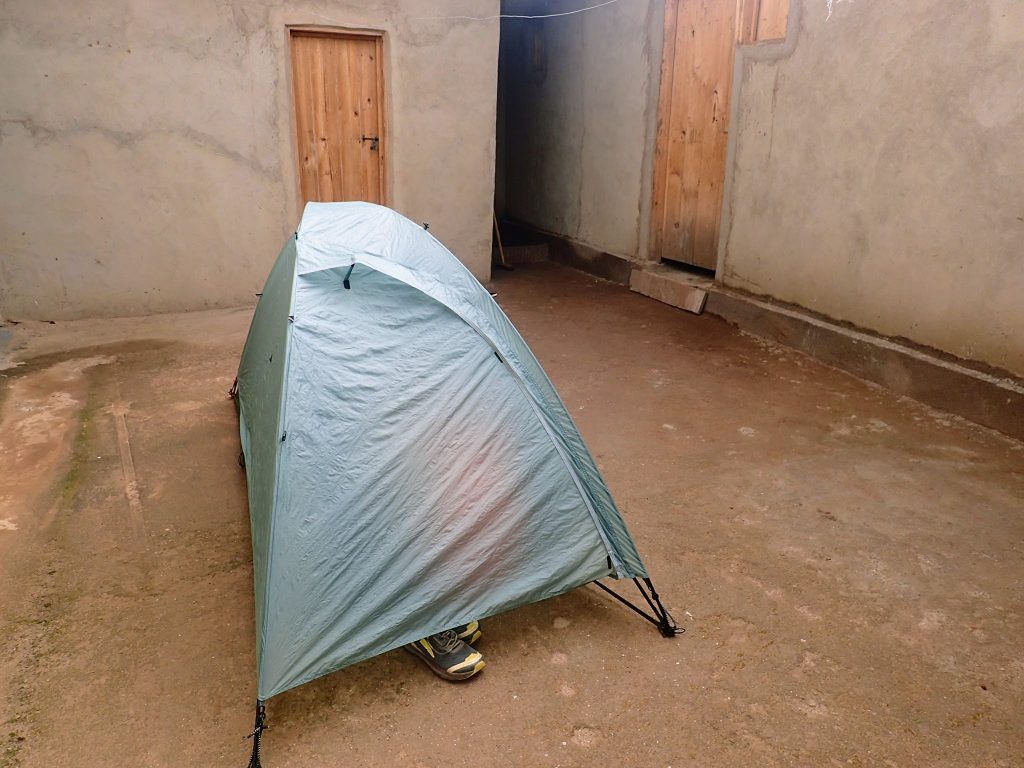
A perfect use case for the Soul’s freestanding vestibule: pitched in an open-air courtyard on a rainy day in Rwanda while hiking the Congo Nile Trail.
Front Entrance
A word needs to be said about the Soul’s front entrance, which is what allows the vestibule to be freestanding. Solo tents more typically have a side door, and some people have strong feelings about a front entrance.
It doesn’t bother me at all, in fact I find it kind of cozy. For some people though, a front door feels like “climbing into a dog house” (to quote someone I know using a different tent with a similar front opening).
If the idea of a front entrance bugs you, the Big Sky Evolution might be a better fit. It shares many of the Soul’s advantages, and though it lacks a freestanding vestibule you can always find a rock or other way to guy out the vestibule when needed.
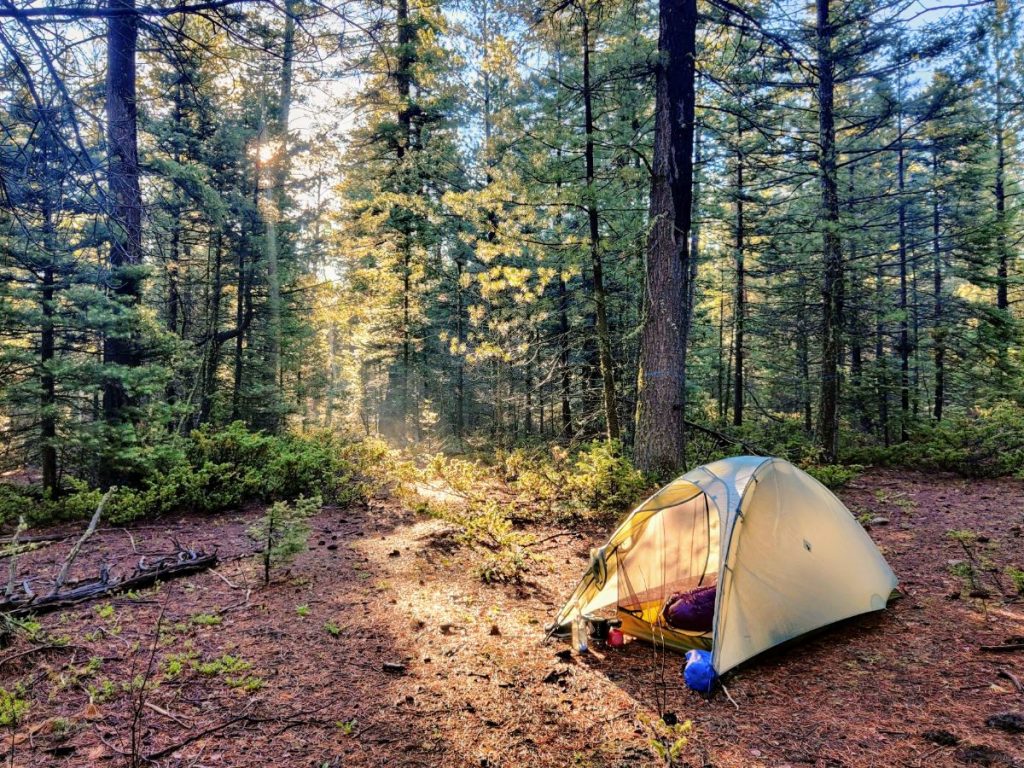
The Soul’s front door is a bit unusual, but I like it (though I need to go zip that door closed, the bugs are getting in!)
Pole Structure
The Soul’s competitors all use a similar type of pole structure: a single pole unit with a long arch down the middle and two short forked segments on both ends, plus a short cross-pole at the peak.
The Soul’s pole structure (same as the Evolution’s) is different: two identical straight poles cross in the middle to create a long X shape. On the Soul the poles extend forward of the inner, creating the front vestibule.
This structure has the benefit of being slightly simpler to set up than its competitors, and there’s a certain elegance to it. I would venture to guess it’s less costly to produce, perhaps contributing to the Soul’s more affordable price, but that’s just speculation.
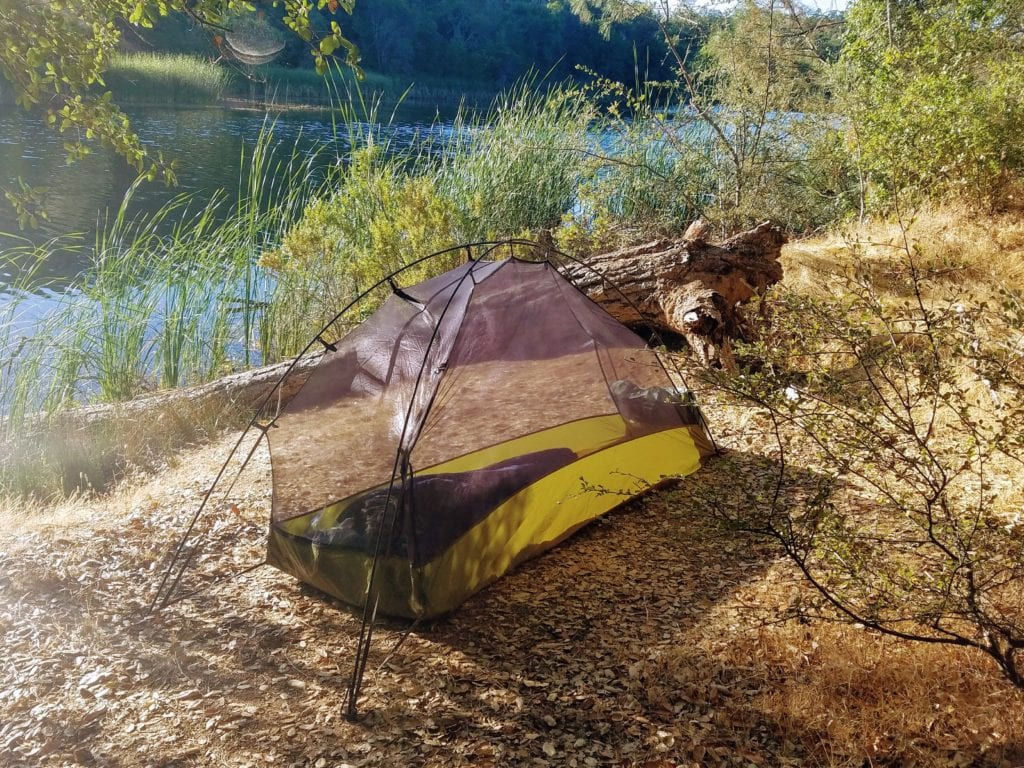
The downside is that without a cross-pole, the head space at the peak is slightly narrower than some tents. For me it’s not a problem because I tend to sit in the wider part of the floor and still have plenty of room for my head. If you are very tall and need to sit with your head exactly at the peak, you may notice the difference.
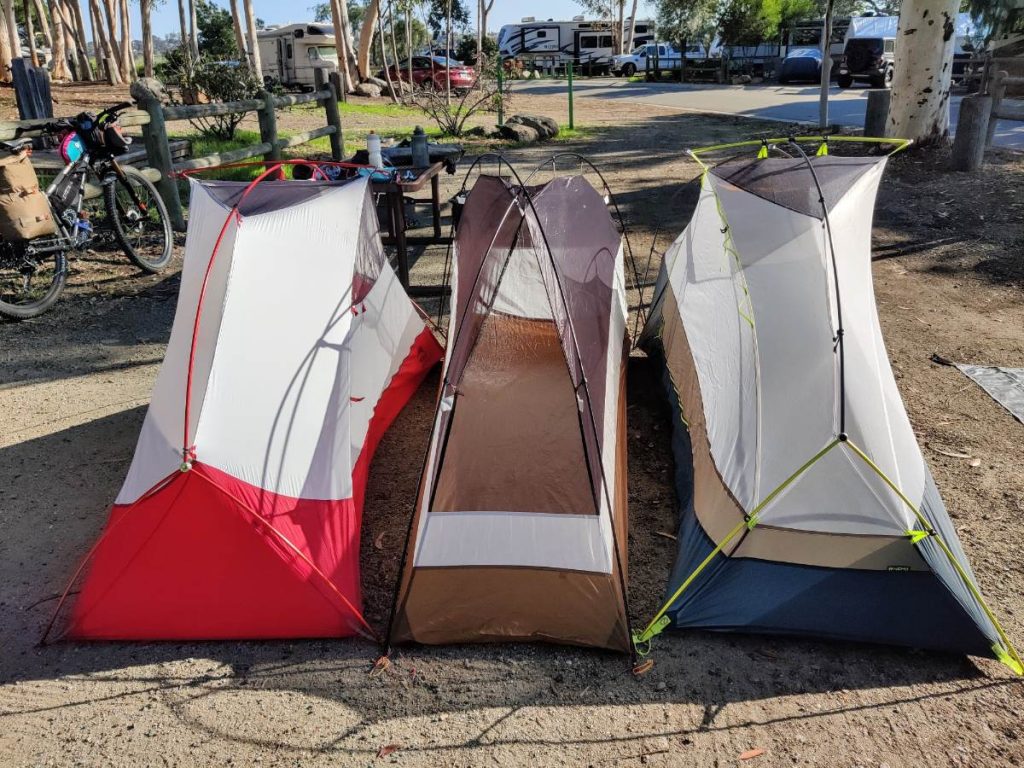
Here you can see how the Soul’s (middle) pole structure differs from those of other freestanding solo bikepacking tents (MSR’s Hubba Hubba on left, NEMO’s Dragonfly on right).
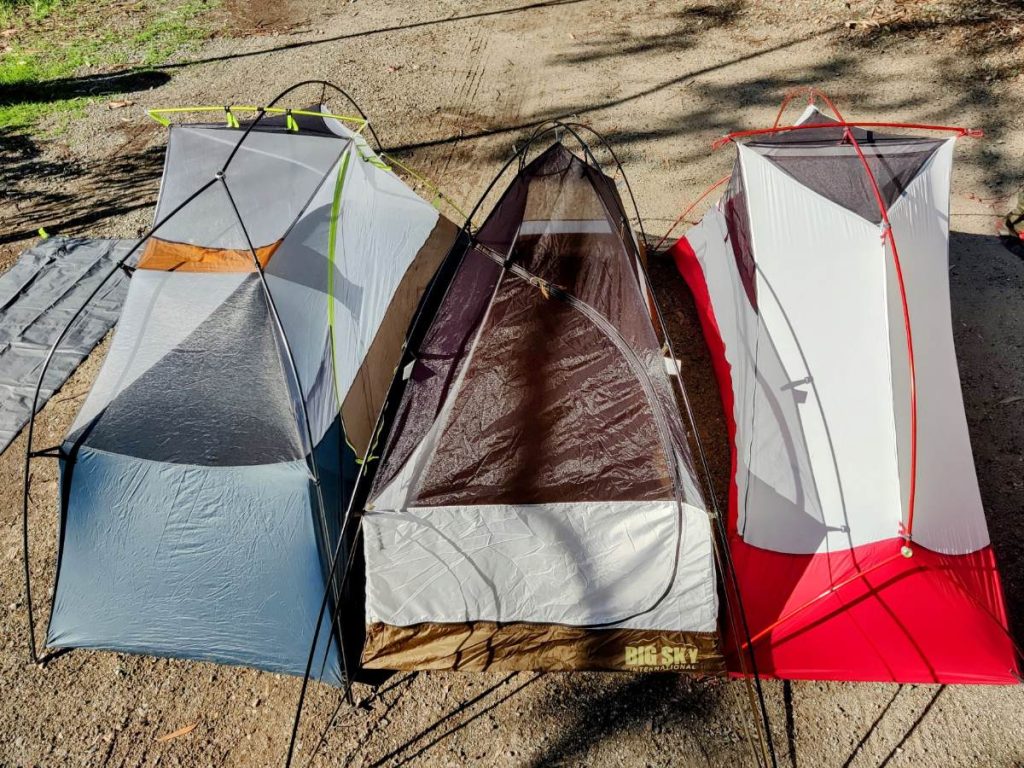
Same tents, taken from the other side (Soul is again in the middle).
Short Bikepacking Poles
Big Sky was one of the first tent manufacturers to offer a “bikepacking version” with poles that fold down shorter. It can be hard to figure out where to pack a tent in a bikepacking setup, but 12″ poles are easier to squeeze between drop bars or stuff into a pannier. Kudos to Big Sky for pioneering this helpful trend!
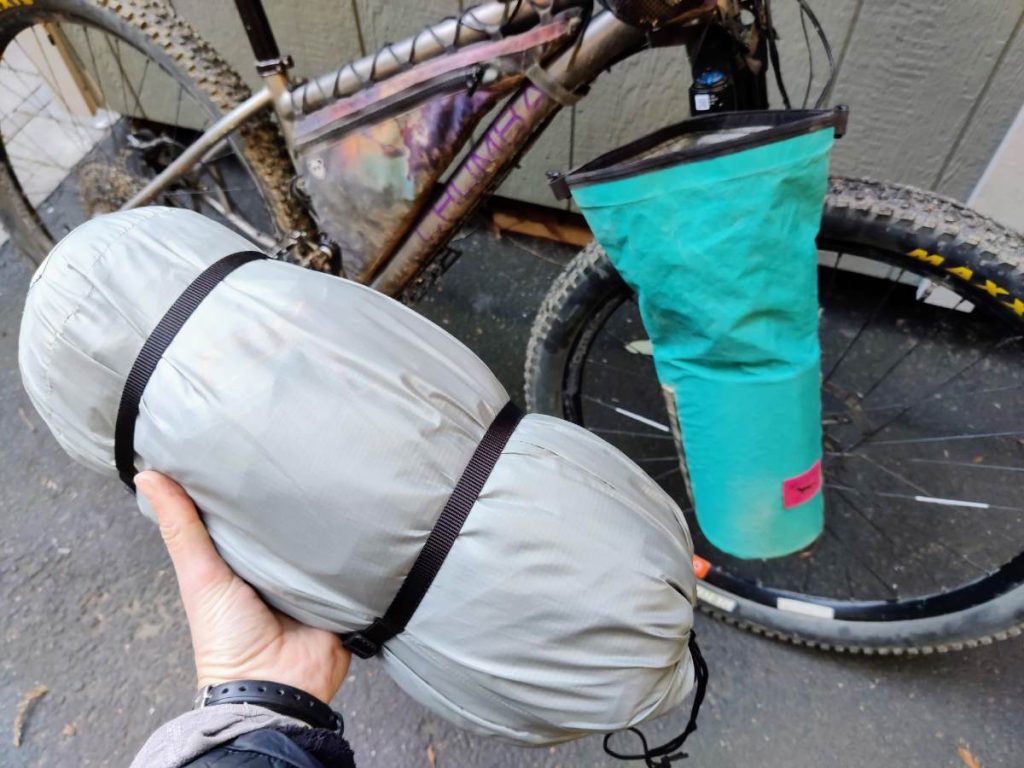
Thanks to its 12″ poles, the Big Sky Soul tent (in my hand) actually fits in that blue fork bag (Swift’s Gemini Cargo Pack)!
The standard-length poles fold to 14.2″ and weigh a few ounces less, so if weight is a bigger concern than space you may prefer the originals.
Setup
The Big Sky Soul 1P is dead-simple to set up and take down. When camping with others I win the tent setup race every time. Not that it’s a competition. 😉
The basics are similar to other freestanding solo tents: Unfold the poles and stick the ends into the fittings on each corner of the inner. Clip the top of the inner to the poles. Then cover with the fly, fastening the interior velcro loops to the poles for greater stability (especially important in wind) and clipping the fly to the pole tips at each corner. When possible, stake or guy out each of the long sides for stability and ventilation.
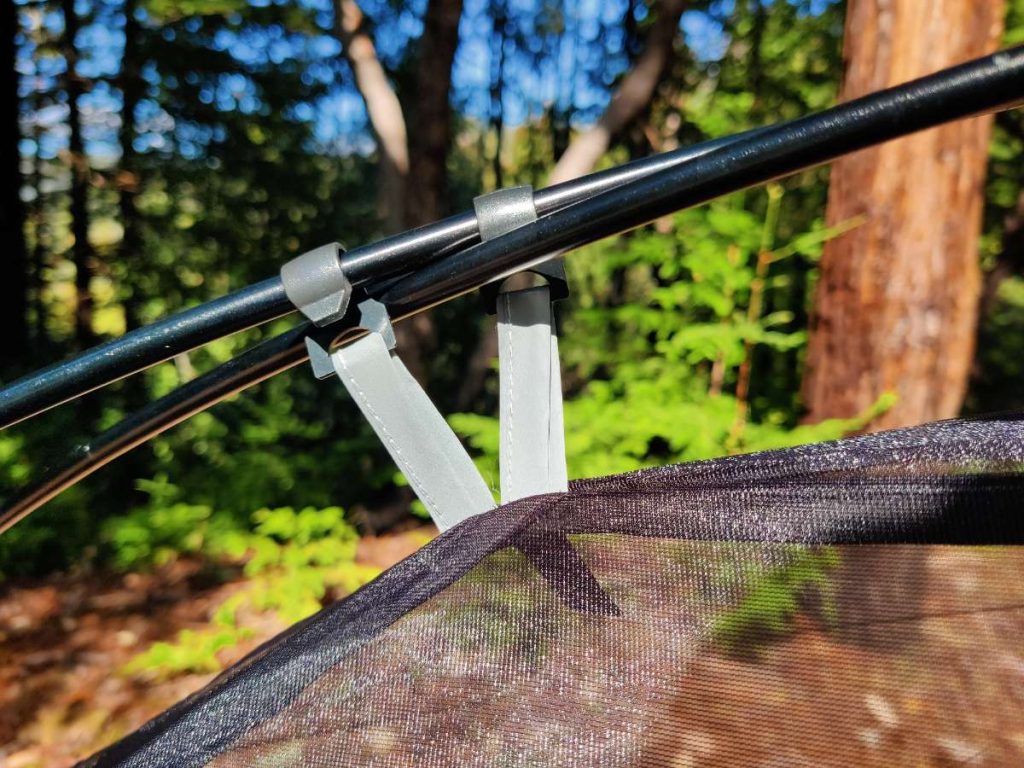
Clipping the inner to the poles
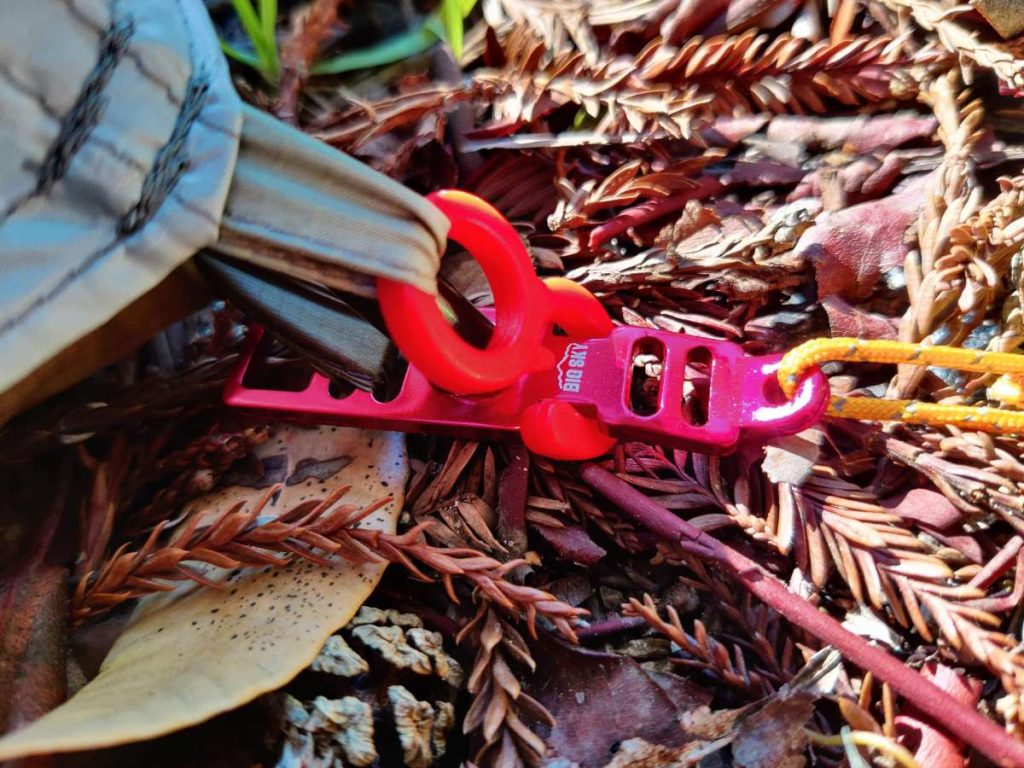
Clipping the fly to the aluminum fitting at the corner
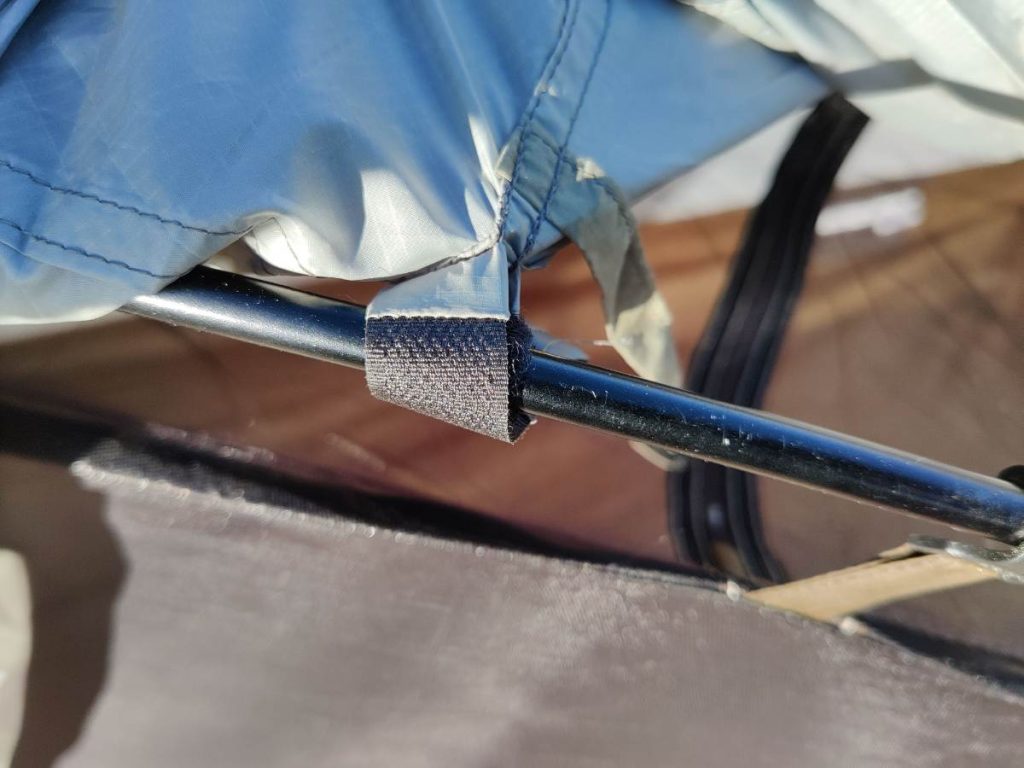
Don’t forget these loops on the inside of the fly! They help stabilize the structure in wind, and also allow for a half-open “moon roof” configuration if you want to stargaze.
If you find yourself needing to set up in the pouring rain, there isn’t a way to pitch the Soul without the inner getting at least a little wet. This hasn’t been a big issue in my adventures, but if you spend a lot of time in soggy climates you might look into Big Sky’s “exoskeleton” tents like the Mirage.
Weight Comparison
Shelters keep getting lighter, and these days most of us care at least a little bit about lightening our load. So how does the Big Sky Soul compare to its competitors in the freestanding solo tent category?
Based on that comparison table, the Soul is the lightest freestanding solo tent by about 5 oz. It’s important to note that packed weight includes the stuff sack, and those other tents come with more fully featured bags. The Hubba Hubba, for example, includes a full-fledged handlebar bag that weighs nearly 8 oz.
Some people find those more elaborate and durable stuff sacks useful for packing their tent on their bike. Others prefer an ultralight sack like the Soul’s. Packed weight also includes stakes, lines, and other items people tend to swap out, so a direct comparison is hard. Let’s just say the Soul is on the light side of the competition if you don’t need a burly stuff sack, and very much in line in general.
Note: If you are looking for the most ultralight shelter available, you should be looking at bivy sacks, tarps, or non-freestanding tents. The Soul is for people who are willing to carry an extra pound or so for the comfort of sleeping in a tent and the simplicity of a freestanding design.
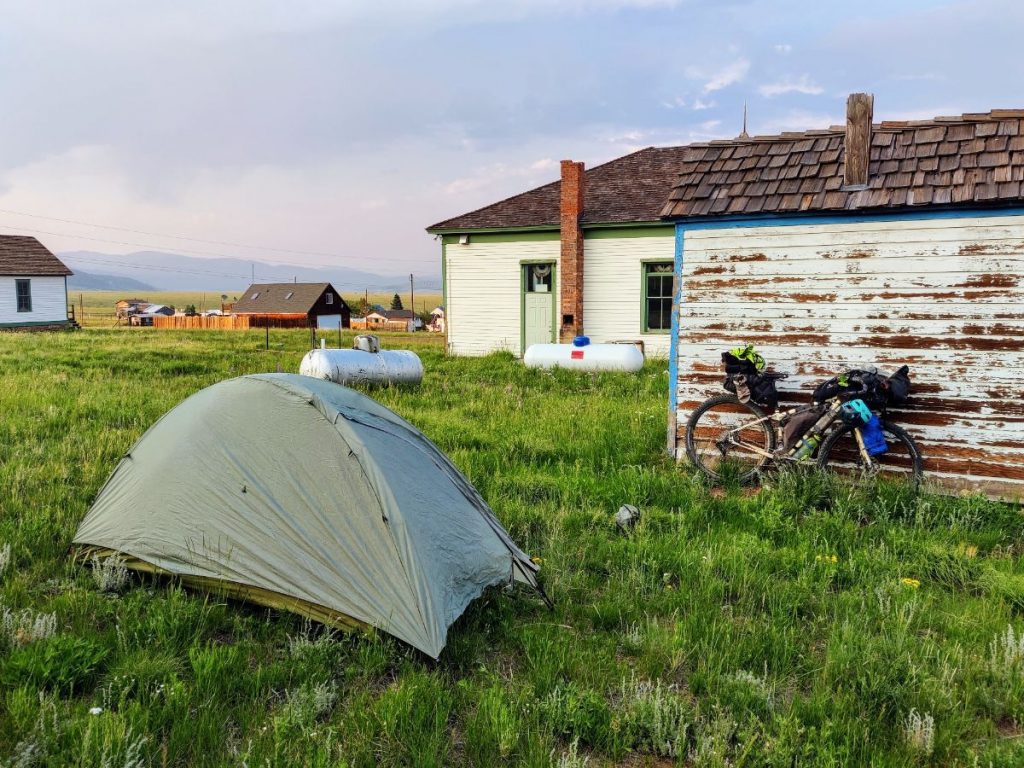
My Soul 1P on the Great Divide Mountain Bike Route in Como, Colorado
Price Comparison
If weight is a close call, price is a no-brainer. The Soul costs at least $150 less than its competitors in the freestanding solo bikepacking tent space. At $350 for the bikepacking pole version and $390 for the regular ultralight poles, this tent is seriously a steal.
Though it lacks some of the bells and whistles touted by bigger brands (pockets, lofts, fancy stuff sacks) I’ve found the Soul to be just as good in terms of quality and reliability. If budget is a big factor for you, my advice would be to choose the Soul without a second thought.
Interior Space
Let me first say that I’m a relatively small person at 5′ 5″ tall. While this makes some aspects of outdoor adventure, like gnarly hike-a-bike and heavy backpacks, more difficult, fitting comfortably into a solo tent is not one of them. I’ll take what I can get!
The Soul uses a trapezoidal floor shape with a significant taper from 36″ to 24″. This is a common strategy for making solo tents feel more spacious, and I personally like it. The Soul’s taper is the most pronounced of its competitors, with 12″ difference between head and foot (the Copper Spur’s 10″ difference is next in line).
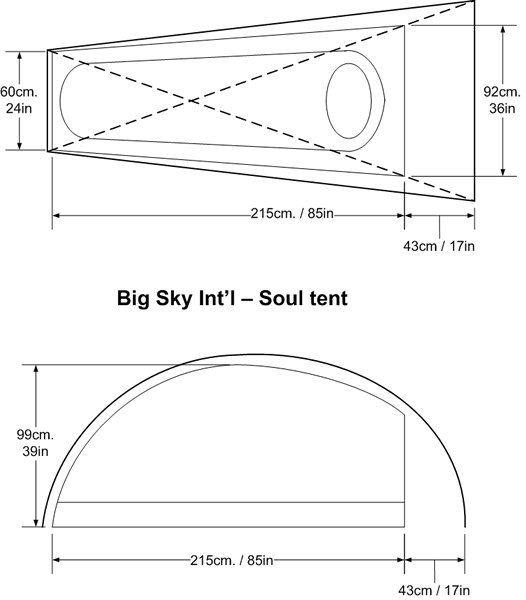
Source: Big Sky Products
At the 36″ wide end, the Soul feels quite spacious. I can store gear on either side of my sleeping pad, and can sit up and move around (and even do my stretching routine) with ease.
The 24″ end is on the narrow side, 4″ narrower than the Copper Spur and a full 8″ narrower than the Dragonfly. On that end there isn’t room for anything besides my sleeping pad.
I discovered while writing this review that I’ve been sleeping the wrong direction in the Soul for years! Big Sky’s diagram shows the head at the wide end, and maybe bigger people with wider shoulders find this obvious. Personally I like to tuck my head in the small end, cozily far from the door, and stash most of my gear at the foot. When I sit up facing the door and looking toward the wide end this makes the tent feel very spacious.
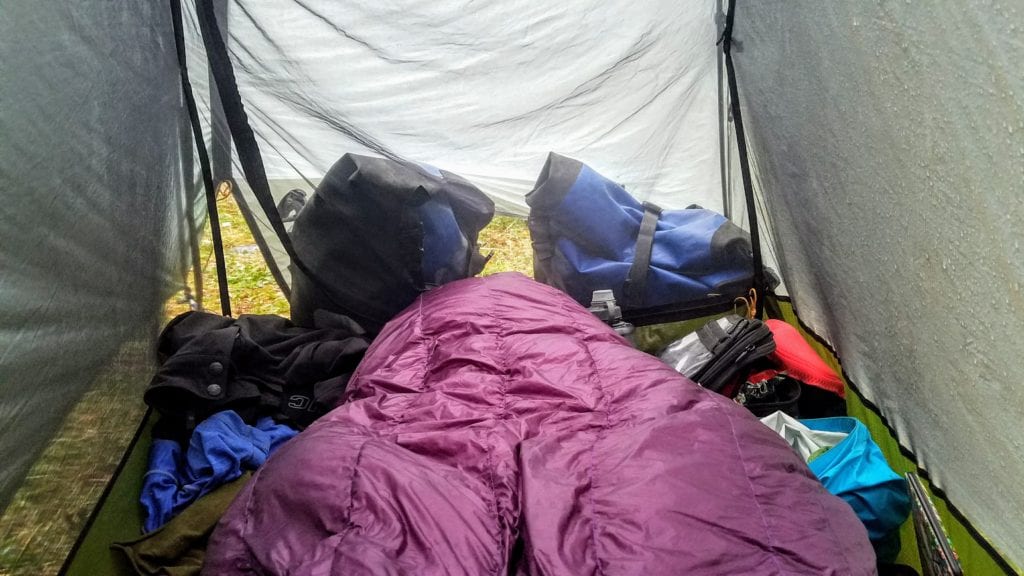
Plenty of room at the wide end for gear.
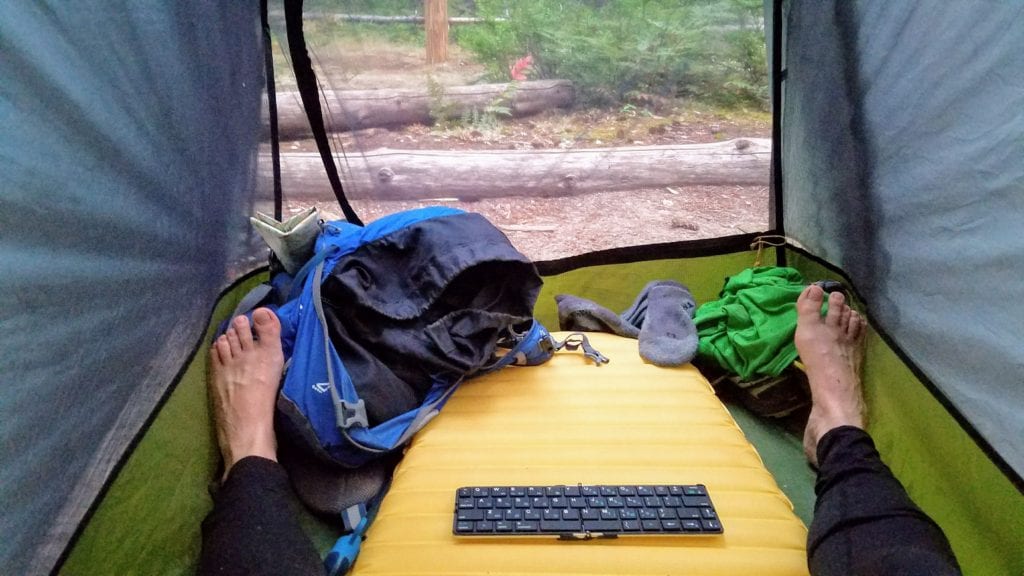
I sleep the “wrong way” in the Soul, with my head at the narrow end.
The Soul’s length is a generous 85″ (somehow slightly longer than the 85″ claimed by the Hubba Hubba). This is on the shorter end for solo tents — the Copper Spur and Dragonfly are both 88″ long — but totally adequate. According to Big Sky the Soul is rated for humans up to 6’1″ tall, though I have to imagine that’s a cozy fit.
Overall the Soul feels significantly roomier to me than the rectangular MSR Hubba Hubba, and slightly less roomy than the Big Agnes Copper Spur (similarly tapered and a bit longer) and the NEMO Dragonfly (both wider and longer).
Tall people take note, the Big Sky Evolution is actually the longest tent of the bunch at 91 inches!
Weather Resistance
As a double-walled tent, the Soul offers good protection from nearly any 3-season weather. Mine has seen torrential rain, howling wind, and a dusting of snow. With proper setup (an important caveat) it has weathered all these challenges admirably.
Rain
I’ve been impressed with the Soul’s rain resistance. It came seam sealed from the factory and has yet to leak in wet weather. The rainfly is well designed and the bathtub floor is tall and holds its shape well. Even in torrential downpours the inside has always stayed nice and dry.
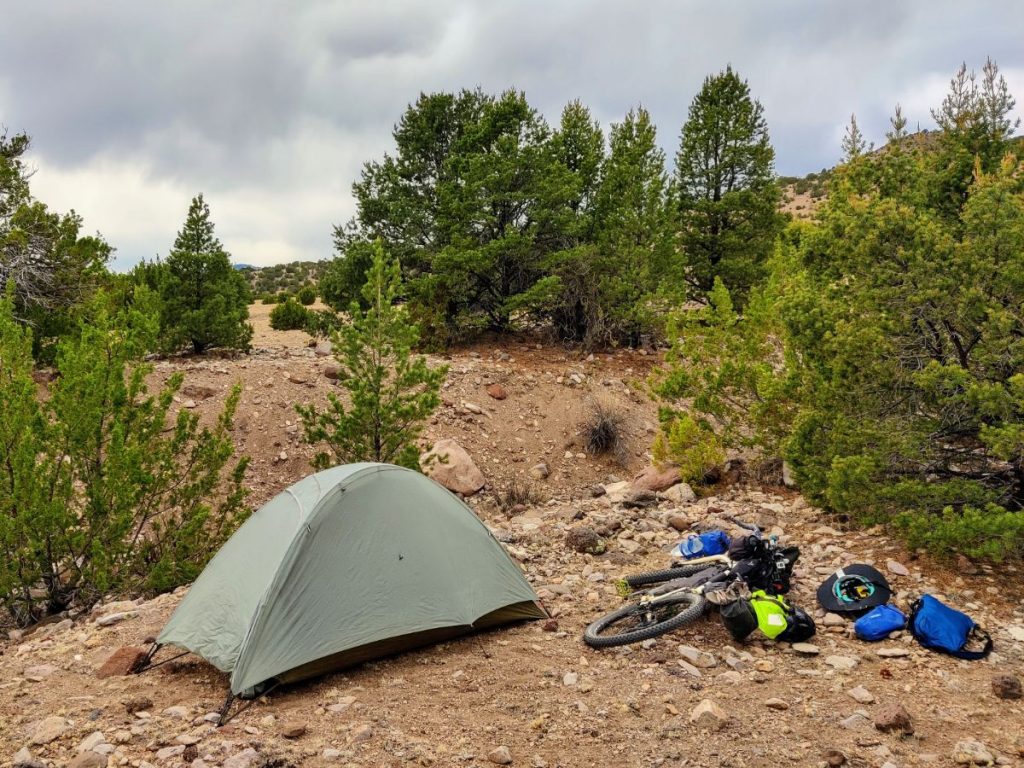
Staying dry during thunderstorms in New Mexico
Snow
My Big Sky Soul has handled a dusting of snow with no issues, but it’s definitely not designed as a winter tent. Big Sky does sell a 4-season tent called the Chinook if you see a lot of snow in your future.

Looking out of my Soul to some surprise October snow in central Oregon
Wind
I’ve used my Soul in the wind plenty of times, but on a recent desert bikepacking trip the gusty nights forced me to refine my pitch to a new level. My conclusion: the Soul does just as well as other freestanding solo tents in strong wind, probably a bit better, but only if you know how to pitch it correctly.
To pitch the Soul, or any other similar tent, in the wind:
- Orient the smallest end into the wind.
- Pound stakes at a 45 degree angle to the ground.
- Use as many stakes or secure guy lines as you can.
- Reinforce stakes with heavy rocks if available, especially the two midpoints of the long sides.
- Use the extra mid-pole guy lines that come preinstalled on the Soul’s fly.
Lastly, there are velcro loops inside the fly along the seams; fasten these to the poles! This transfers the stability of the fly (assuming it’s properly guyed out) to the poles so they don’t “scissor” toward each other under the fly.
This is speculation, but I’m thinking the Soul’s X-shaped pole structure is very resistant to breaking in the wind if you mess up your pitch. The worst case is that the poles scissor together and the tent collapses to the side, but there are no rigid joints like most other freestanding tents.
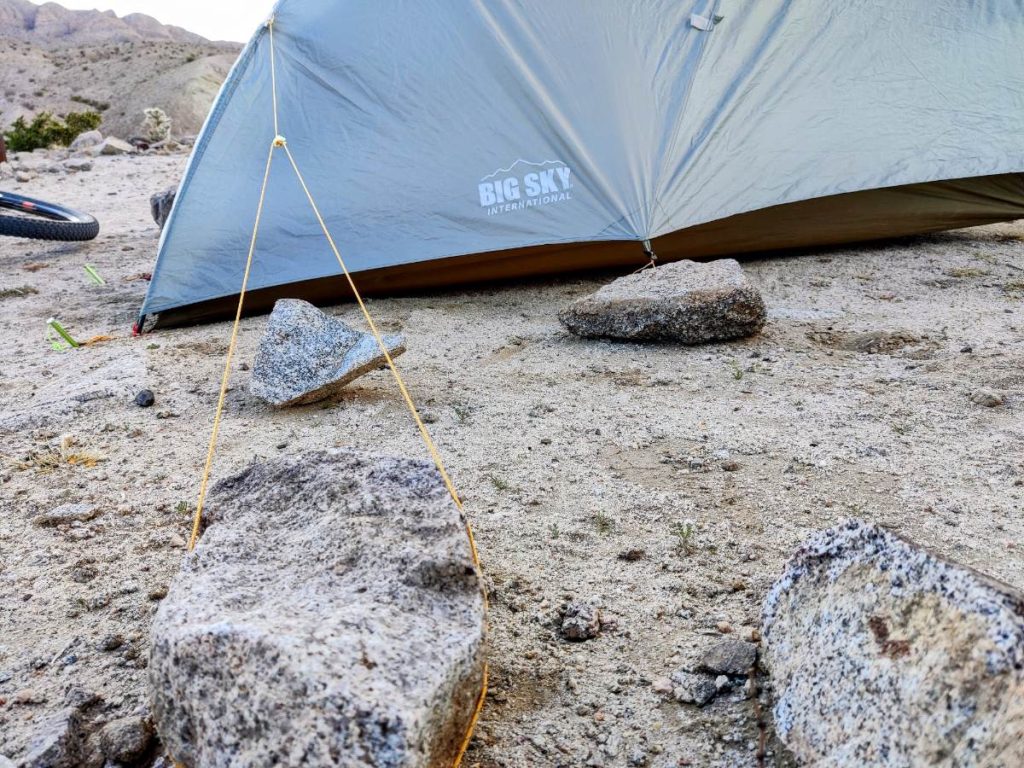
Using ALL the Sky’s guylines for extra stability on a windy desert evening.

These loops attach the fly to the poles, helping to stabilize the structure in wind.
Ventilation and Condensation
As a double-wall tent, the Soul mostly avoids issues with condensation that tend to plague ultralight single-wall shelters. Though some buildup is inevitable, the fly’s design allows it to run downward without dripping into the interior.
Though the Soul is freestanding and doesn’t need stakes on the long sides for structure, they do help with ventilation. When possible I always stake out the two midpoints to hold the fly off the inner for better airflow. The substantial amount of mesh on the inner helps with ventilation, as does the generously sized rain-proof vent at the top of the fly door.
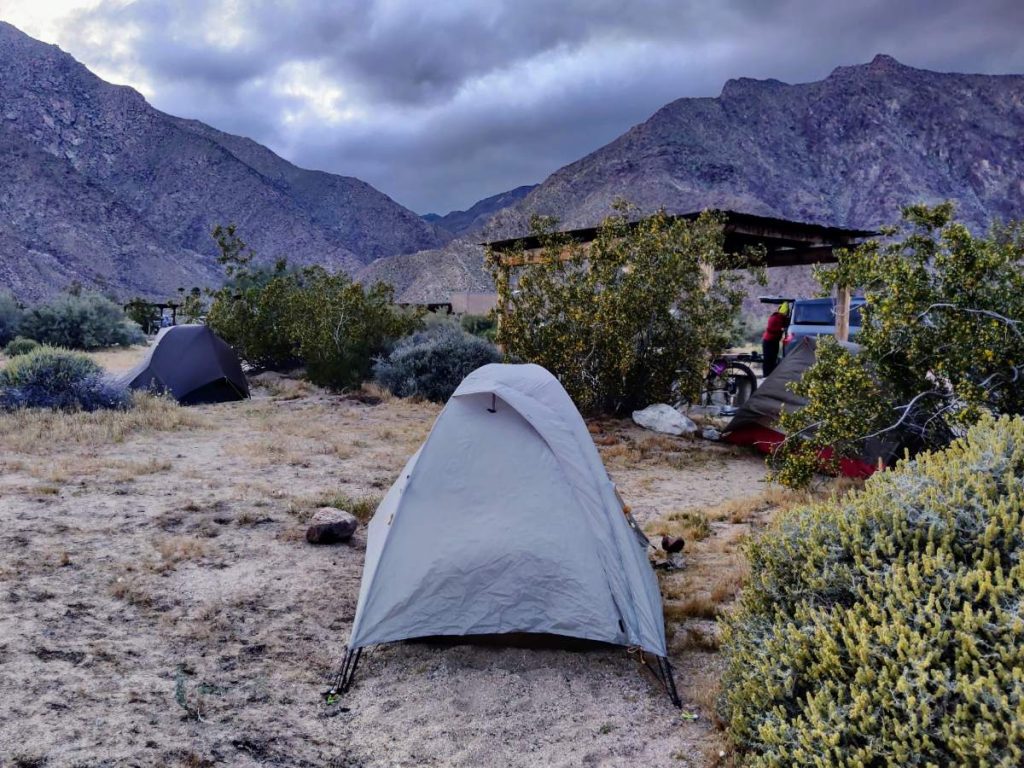
Here you can see the vent propped open at the top of the door.
Features or Lack Thereof (Pockets, Lofts)
This is a rare area where the Soul lacks in comparison to its competitors. The Hubba Hubba, Dragonfly, and Copper Spur are loaded up with bells and whistles: mesh pockets, overhead gear lofts, clothes drying loops, helmet holders, vestibule floors…
The Soul takes a more minimalist approach, offering a single mesh pocket at the narrow end of the inner. This is a common theme with ultralight gear made by small companies versus larger mass-market brands. I suspect the simplicity is part of what allows small gear makers to compete with the big brands in price.
I will admit that I use and enjoy these features in tents that have them. I find gear lofts especially useful for drying out damp clothes overnight. But I manage fine without them in the Soul, and if needed you could always hang your own lines for drying.
Durability
I put my original Soul through some very tough conditions, from humid jungles to sandy deserts. For its weight I think the durability is very good, but mine did have a few issues after years of heavy use.
The floor developed a few worn spots, mainly cosmetic. I don’t use a ground sheet, which probably contributed. I painted silicone seam sealer over them and had no further issues.
The shock cord inside the poles stretched beyond the point of holding the segments together. This would have become an annoying problem, but I ordered replacement poles from Big Sky.
Lastly, the zipper became increasingly unreliable along the curved section. I babied it for awhile with cleaning and lubing, but eventually this is what caused me to upgrade to the new version in 2023.
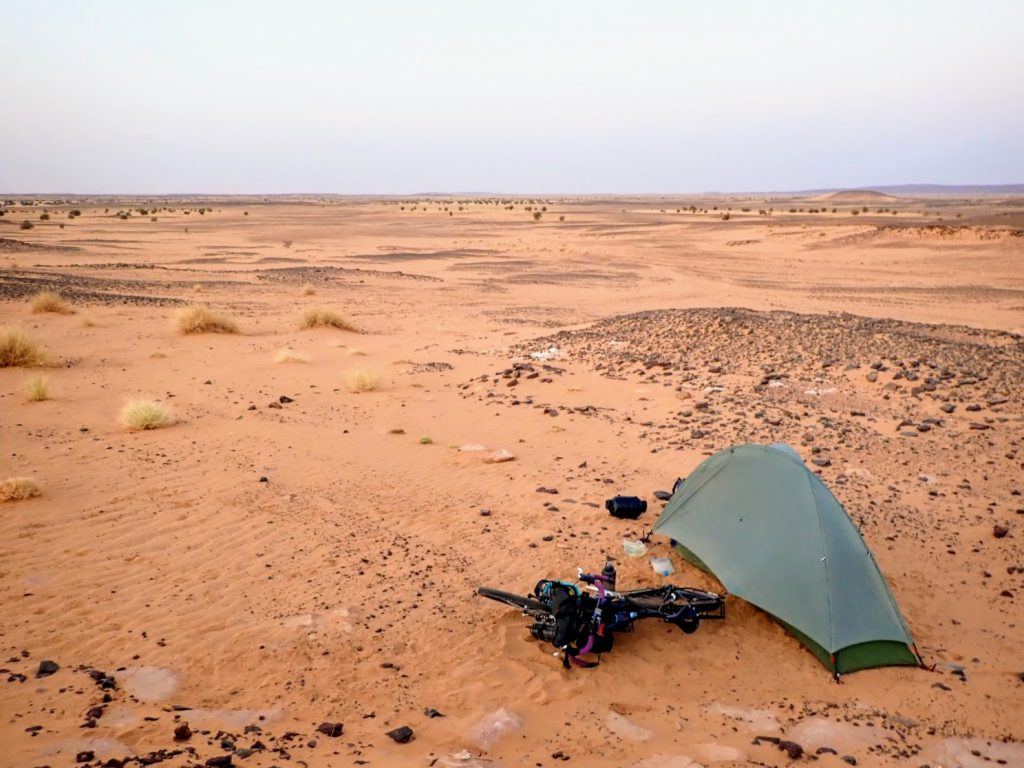
My Big Sky Soul in the sandy Sahara desert in Sudan – a rough environment for gear!
Packed Size and Compression Sack
When packed in its compression sack, the Soul 1P bikepack version measures 6″ diameter by 12″ long. That’s compact enough to easily fit on handlebars (drop or flat), in a pannier, or even in a cargo cage.
I especially like that the stuff sack is roomy before the straps are cinched down. This makes it a breeze to pack up every morning, which anyone who’s ever wrestled a big tent into a small stuff sack can appreciate.
Some other bikepacking-specific tents (Copper Spur, Hubba Hubba) come with burly, elaborate stuff sacks meant to strap directly to the handlebars of a bike. This can be handy if you don’t have a handlebar bag setup already, but those sacks won’t be as versatile and durable as a real handlebar harness, which you’ll probably end up buying anyway if you bikepack a lot.
The Soul instead uses an ultralight stuff sack that can be carried however you please. I do sometimes carry it on my handlebars or fork, but it needs care — you can’t buzz your tire on it when the harness sags, or lay your bike down on top of it in gravel.
Overall I prefer to save a few ounces thanks to the Soul’s minimalist stuff sack, because I already have a pile of bikepacking bags and I know how to be careful with my gear.
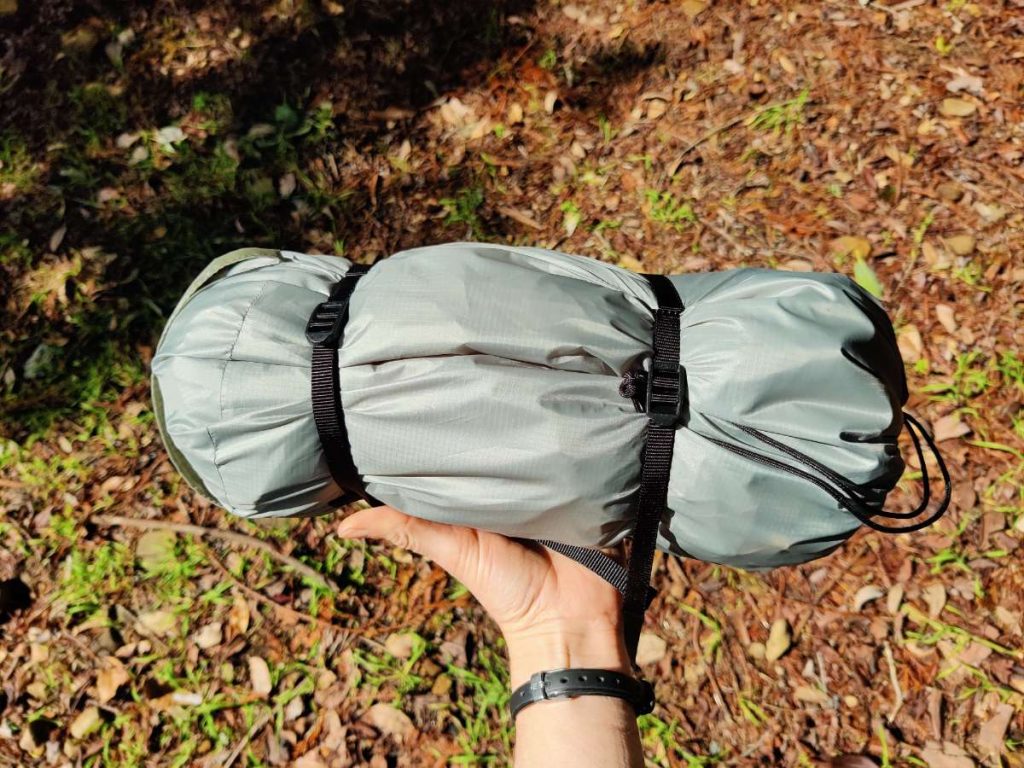
In Conclusion
As I’m sure you can tell by now, I highly recommend the Big Sky Soul 1P to anyone looking for a lightweight and freestanding solo tent. It holds its own across that category, but the bargain price and simplicity of setup make it an obvious winner in my opinion.
I’ve become quite attached to my Soul, and not just because we’ve been on some crazy adventures together. It’s been my reliable companion for a few years now, and though I’ve tried a number of other tents in the interim, I expect to keep using it for many years to come.
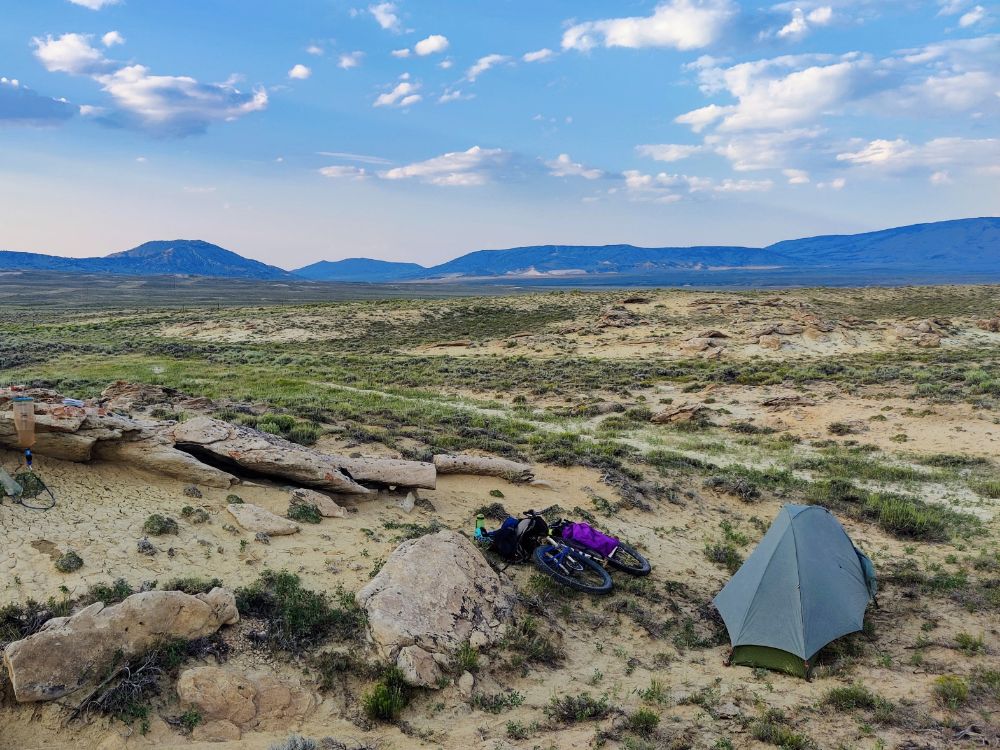
One more gratuitous picture of my Soul tent in a beautiful place, because I have so many and can’t resist. (Great Basin of Wyoming)
If you liked this review, you might also find these helpful:
Or, visit the bikepacking section for lots more!
About the Author
Hi there, I’m Alissa, founder of Exploring Wild. I’ve traveled over 19,000 miles by bike and still can’t stop planning my next ride (and helping you plan yours). Pavement and panniers or singletrack and seat bag, I love it all. On my bike I feel free. Learn more about me here.
Shop Bikepacking Resources
Bike resources in your inbox?
There’s more where this came from! Sign up here for occasional emails full of inspiration and information about bikepacking and bicycle touring.

The post Long-Term Review: Big Sky Soul 1P Tent (Bikepacking and More) appeared first on Exploring Wild.
https://exploringwild.com/big-sky-soul-1p-tent-review/?utm_source=rss&utm_medium=rss&utm_campaign=big-sky-soul-1p-tent-review
 CampingSurvivalistHuntingFishingExploringHikingPrivacy PolicyTerms And Conditions
CampingSurvivalistHuntingFishingExploringHikingPrivacy PolicyTerms And Conditions
